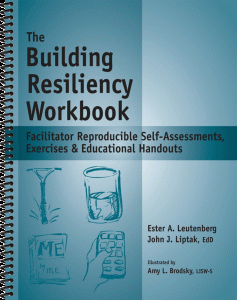Locus of Control – Who controls my life?
Exerpted from The Building Resiliency Workbook by
Ester R.A. Leutenberg and John J.Liptak, EdD
Locus of Control refers to your beliefs about what causes the good or bad things that happen in your life. It is the extent to which you believe that you can control the events that affect you in your personal and professional life.

Think about where you would place yourself on a continuum such as the one above. Most of us place ourselves in the middle somewhere. If you placed yourself high on the continuum you believe your life is guided by your own personal decisions and efforts. If you are in the middle somewhere, you believe your life is guided by a combination of your own efforts and some external circumstances. If you placed yourself on the low end, you believe your life is guided by fate, luck, or other external circumstances.
Here are some questions to think about as you discover how your locus of control developed:
- What did your mother/female caregiver believe about the factors that lead to success or failure?
- What did your mother/female caregiver believe about luck leading to success or failure?
- What did your father/male caregiver believe about the factors that lead to success or failure?
- What did your father/male caregiver believe about luck leading to success or failure?
- As a child growing up, how were you encouraged to take responsibility for your own destiny?
- As a child growing up, how did your cultural, spiritual and/or religious beliefs affect your thoughts about your destiny?
- Before you go on, journal about these questions and ponder how they influenced you as an adult.
Next, take a look at what you have contributed to the successes in your life. List your success and how you contributed to it.

Do the same with your disappointments. How did you contribute to your future in a negative way?
Review the negative situations and decide how you can have a more positive impact in your future decisions.
One way to have more control over what happens daily is to create a situation for yourself where good things can happen. You may need to change your patterns within your family, friendships and work. For example, I could change my bowling league so I can go to my children’s baseball games on Thursday nights. This will help because my spouse will feel supported and the children will be happy that I’m there for them.
Create a two column list of “Better Situations for Me” and “How this can help”.
Now…create an action plan!
Step 1 – My Life
Identify areas in your life where you feel dissatisfied or in a rut. Think about where you feel unfulfilled – relationships, work, family responsibilities, hopes and dreams, etc. Write down one of your unfulfilled areas. For example: further education.
Step 2 – Look at your attitude
Take a look at your attitude as it relates to the area you identified above in Step 1. It is through your attitude that you limit yourself and remain stuck? By confronting and changing your attitude, you can empower yourself to make positive changes in your life.
Think about the negative and limiting attitudes. What might be keeping you stuck? Here are some possibilities:
FAMILY BELIEFS:
My family passed on these negative beliefs to me about my ability to influence my life. For example, “You don’t have the brains you were born with.”
PERSONAL LIMITATIONS AND BELIEFS:
What attitudes and beliefs do you have about yourself that limit your exerting control over your situation? Examples: I do not have enough life skills. I will never succeed. I am not a smart as other people. I do not communicate very well.
Now you try. List the personal limitations and beliefs you have about yourself.
You may have negative attitudes about other people in your life. For example: My peers think they are so smart or my partner doesn’t respect what I have to say, or my supervisor doesn’t think I deserve a promotion or (my kids all-time favorite) my parents are to blame.
Now you try. List the negative attitudes and beliefs you have about people in your life.
Remember, it is what YOU believe about yourself, NOT what other believe about you, that can influence you in either a positive or a negative way.
Step 3 – Changing Your Attitude
In Step 3 you have the opportunity to identify ways to change negative attitudes and move past the issues you have identified in Step 1. These attitudes and beliefs can be overcome with a few simple techniques:
Notice when negative thoughts pop into your head. Stop that negative self-talk, challenge it and substitute more positive self-talk.
Now that you have identified negative thoughts and attitudes in Step 2, think about whether the thoughts are accurate or not. What evidence is there for their accuracy?
List you negative thoughts and the evidence you have for their accuracy.
For example: Negative attitude – I’m not smart enough to go to college.
Evidence for these attitudes – Nothing, other than what my parents told me.
Create two columns on a sheet of paper. Repeat your negative attitudes from the previous page in the first column and then substitute positive thoughts for those negative thoughts. For example, the negative attitude might be I cannot get further at my place of work because I don’t have enough computer skills. A substitute positive thought might be I am smart enough to go to college. I will start with a community college where I can receive personalized assistance.
Step 4 – Goals for Change
Goals can help you regain control in your life. List several of your goals and hopes related to the area in which you feel stuck. For example: I want a job where I feel more challenged. I want to further my education. I want to learn more about technology. I want to feel smart.
List two goals related to the unfulfilled area you identified in Step 1.
Step 5 – Identify short-term steps – begin moving toward your goals.
These short-term steps are action-oriented activities to move you toward the general goals you identified in the last step. Create another two column table. Title one column Steps I will Take for One of My Goals and the other Deadlines for Completing Steps. List the short-term steps you will be taking to reach ONE of your goals and the deadlines you set for completing each step. For example: I will call my local community college and make an appointment with a counselor – deadline: tomorrow. And I will keep my appointment with the counselor, even if I am apprehensive! – deadline: next week. And if I like the school I will fill out an application. If not, I’ll look for another one – deadline the next day.
Step 6 – Take Action
It’s time to take action by taking control of your life. List the steps you have completed and the steps you are having trouble completing on two sheets of paper.
Why do you think you are having trouble completing some of the steps? Can you revise them to make them more doable? Write out your solution.
How has this process, or how will this process, help you to take greater control of the events in your life? Again, write out your answer.
Part of the trick, of course, is to constantly update your lists and goals. Don’t be afraid to make changes. Celebrate your successes. Rework those challenges that didn’t go as well and try again. Success is in your hands!
The article above was excerpted from The Building Resiliency Workbook by Ester R.A. Leutenberg and John J. Liptak, EdD. Included is a chapter on Locus of Control with worksheets to make the tasks above easier to accomplish for your participants. Questions: call 800-247-6789 and one of our experts will help.


